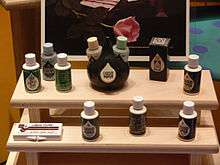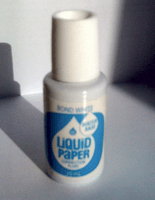Liquid Paper

Liquid Paper is a brand of the Newell Rubbermaid company that sells correction fluid, correction pens, and correction tape. Mainly used to correct typewriting in the past, correction products now mostly cover handwriting mistakes.
Brand history

In 1956, Bette Nesmith Graham (mother to Michael Nesmith, of the 1960s band The Monkees) invented the first correction fluid in her kitchen. Working as a typist, she used to make many mistakes and always strived for a way to correct them. Starting on a basis of tempera paint she mixed with a common kitchen blender, she called the outcome fluid Mistake Out and started to provide her co-workers with small bottles on which the brand's name was displayed.
By 1958, Graham founded the Mistake Out Company and continued working from her kitchen nights and weekends to produce small batches of correction bottles. She was fired from her typist job as executive secretary after she made a mistake by typing in her company name (Mistake Out Company at that time[1]) instead of her employer's name (Texas Bank and Trust[2]) on a piece of correspondence. After this stroke of bad luck, she decided to devote her time to her new company.[3]
The inventor offered the product to IBM, which declined the offer. She sold the product from her house for 17 years; the name was changed to Liquid Paper shortly after. By 1968, the product was profitable, and in 1979 the Liquid Paper Corporation was sold to the Gillette Corporation for $47.5 million with royalties.
In 2000, Liquid Paper was acquired by Newell Rubbermaid. In some regions of the world, Liquid Paper is now endorsed by Papermate, a widely known writing instruments brand (also owned by Newell Rubbermaid).
Graham's son Mike Nesmith, who first achieved fame as guitarist/singer in the popular 1960s pop band The Monkees, was the primary heir to her fortune upon her death in 1980.
Ingredients

Current MSDSs list Liquid Paper as containing titanium dioxide, solvent naphtha, mineral spirits, resins, dispersant, and fragrances.[4]
Liquid Paper came under scrutiny in the 1980s, due to concerns over recreational sniffing of the product. The organic solvent 1,1,1-trichloroethane was used as a thinner in the product.[5] Liquid Paper using this thinner was thought to be toxic and a carcinogen, but later studies have shown that although the thinner used was toxic there was no evidence of carcinogenicity.[6] There were a number of studies linking fatalities[7][8] to the trichloroethane contained in correction fluids, including Liquid Paper.
In 1989, Gillette reformulated Liquid Paper such that it did not use trichloroethane. This was done in response to a complaint under California Proposition 65.[9][10]
See also
References
- ↑ http://inventors.about.com/od/lstartinventions/a/liquid_paper.htm
- ↑ http://www.women-inventors.com/Bette-Nesmith-Graham.asp
- ↑ "Bette Nesmith Graham" (PDF). Celebrating Texas. Retrieved 2010-03-18.
- ↑ "Paper Mate Liquid Paper Fast Drying Correction Fluid" (PDF). MATERIAL SAFETY DATA SHEET - MSDS #: 56401. Sanford NA. 2003. Retrieved 2009-08-18.
- ↑ "Liquid Paper Correction Fluid, White. Material Safety Data Sheet". Ohio State University College of Biological Sciences. 1 January 1985. Archived from the original on 22 July 2009.
- ↑ Sullivan, John Burke; Krieger, Gary R. (2001). Clinical environmental health and toxic exposures. Philadelphia: Lippincott Williams & Wilkins. p. 497. ISBN 0-683-08027-X. OCLC 41606485.
Trichloroethane generally is less toxic than methylene chloride ... is not teratogenic and carcinogenicity and mutagenicity testing has proven inconclusive.
- ↑ King, Gregory S.; Smialek, John E.; Troutman, William G. (15 March 1985). "Sudden Death in Adolescents Resulting From the Inhalation of Typewriter Correction Fluid". JAMA: the Journal of the American Medical Association. 253 (11): 1604–6. doi:10.1001/jama.253.11.1604. PMID 3974043.
We describe four cases of sudden death in adolescents associated with recreational sniffing of typewriter correction fluid occurring during the period 1979 through mid-1984.
- ↑ D'costa, DF; Gunasekera, NP (August 1990). "Fatal cerebral oedema following trichloroethane abuse". Journal of the Royal Society of Medicine. 83 (8): 533–534. PMC 1292788
 . PMID 2231588. Cite uses deprecated parameter
. PMID 2231588. Cite uses deprecated parameter |coauthors=(help) - ↑ Paddock, Richard C. (29 September 1989). "Gillette Agrees to Remove Toxics From Its Paper Correction Fluid". Sacramento: Los Angeles Times. Archived from the original on 22 July 2009. Retrieved 23 July 2009.
- ↑ Estrin, Norman F.; Akerson, James M. (2000). "Proposition 65". Cosmetic regulation in a competitive environment. New York, New York: Marcel Dekker. p. 138. ISBN 0-8247-7516-3. Retrieved 23 July 2009.
Gillette agreed to reformulate the product so that it would not pose a risk requiring a Proposition 65 warning
External links
- Newell Rubbermaid official website
- Papermate US website
- Official Web site
- Liquid Paper on inventors.about.com